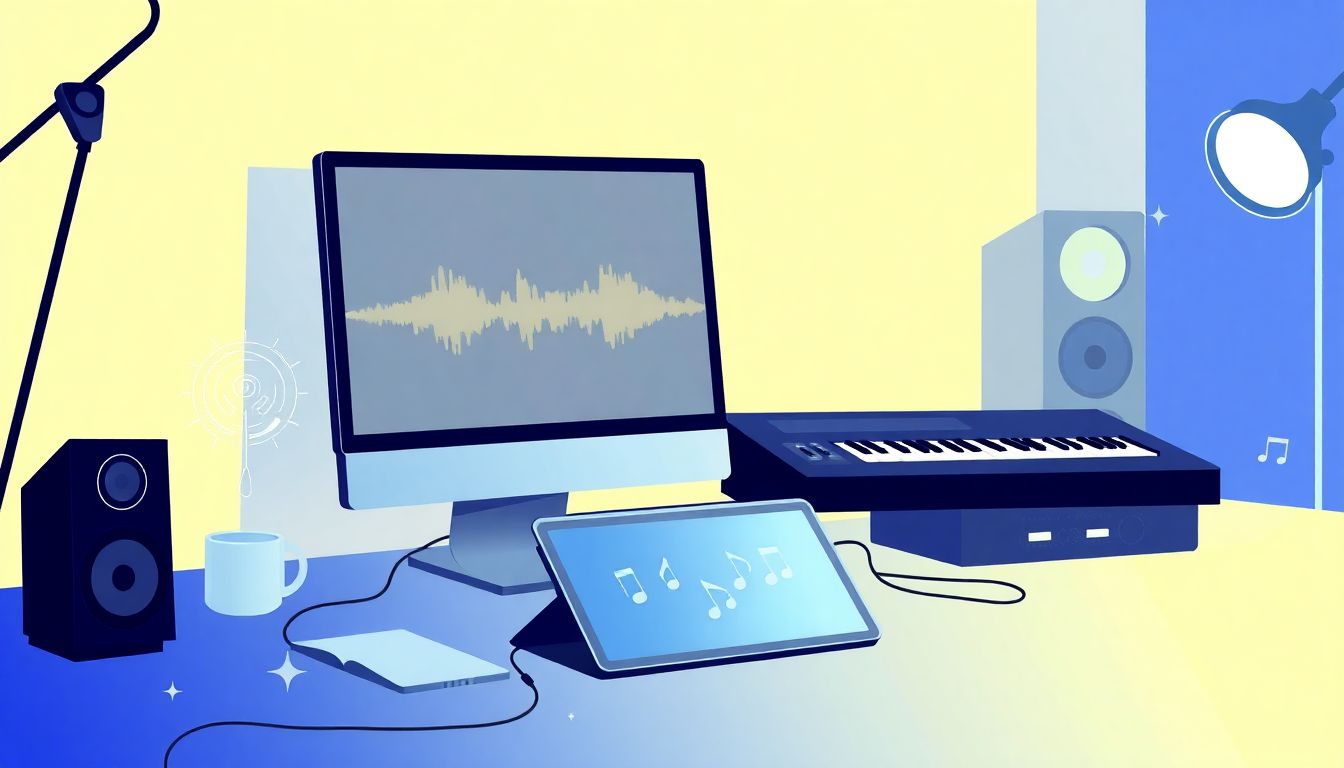If you’re curious about making music with the help of AI, you’re not alone—tech is transforming how tunes are created. But with so many tools out there, choosing the right one can feel overwhelming. Keep reading, and I’ll show you how these tools work and introduce you to the top options in 2025, so you can start creating your own melodies with ease.
Key Takeaways
Key Takeaways
- AI music tools analyze existing songs to generate melodies, rhythms, and harmonies based on input prompts like genre or mood. They act as digital collaborators, helping users create music faster and easier.
- Choosing the right AI tool depends on user interface, genre options, customization features, and budget. Simple and intuitive platforms are best for quick projects, while others suit more detailed needs.
- The AI music market is growing fast, with projections reaching over $3 billion by 2029. Major companies are continuously adding features like real-time collaboration and smarter style blending.
- Top players like Landr, Amper, and Aiva offer unique strengths—such as mastering, royalty-free tracks, and MIDI editing—making AI music accessible for different creative purposes.
- AI-generated music can sometimes lack emotional depth and face legal questions regarding licensing, so users should review licensing terms and attribute AI work when needed.
- Incorporating AI into your workflow involves creating drafts, exporting tracks in compatible formats, and customizing in digital audio workstations. Experimenting with combining outputs enhances creativity.
- Advances in AI will lead to more realistic and emotionally resonant music, making AI a helpful partner for musicians, brands, and content creators to produce tunes quickly and affordably.

How AI Music Creation Tools Work
AI music creation tools generate music by analyzing large datasets of existing songs and learning patterns within them. Instead of composers manually crafting each note, these systems use algorithms to produce melodies, rhythms, and harmonies based on input parameters or prompts.
Most tools operate on machine learning models, especially neural networks, which are trained to understand what makes a piece of music sound good. For example, they learn from millions of audio samples to mimic styles or generate entirely new compositions that fit specific genres or moods.
One of the simplest ways to think about it: you give the AI a starting point—like a genre or mood—and it creates a song or loop that matches. Some platforms also allow tweaking parameters or adding samples, making it feel like you’re collaborating with a digital musician instead of programming from scratch.
What to Consider When Choosing AI Music Tools
When picking an AI music tool, the user interface really matters. You don’t want to wrestle with a complicated setup just to make a quick beat, so look for tools that are intuitive and user-friendly.
Different tools excel in producing various genres and styles, so check if the platform offers the variety you’re after, whether it’s electronic, classical, pop, or niche genres. Customization options like adjusting tempo, instrumentation, or mood can take your tracks from generic to personalized.
Pricing varies from free plans with limited features to monthly subscriptions or pay-per-use models. Think about your needs and budget. Some tools, like [Suno AI](suno.ai), offer credit-based systems, while others have tiered subscriptions or one-time payments.
Top AI Music Creation Tools in 2025

Market Growth and Future Prospects for AI Music Creation
The AI music creation industry is expanding rapidly.
In 2024, the global market was valued at around $2.9 billion, with cloud-based solutions taking up over 70% of the share.
By 2025, this market is expected to hit approximately $1.72 billion, showing solid growth potential.
Projections suggest that by 2029, the AI music market could reach over $3.2 billion, growing at a compound annual growth rate (CAGR) of about 16%.
This means more musicians, brands, and content creators will likely turn to AI tools for faster and cheaper music production.
Furthermore, the market for AI-driven music services is set to hit $500 million in 2025, with ongoing growth driven by improvements in AI algorithms and increased demand for personalized content.
Across regions, the Asia-Pacific zone shows strong adoption, especially among indie artists and small studios, thanks to more affordable solutions.
Key companies like Landr, Amper Music, and Shazam are leading the charge, pushing new features and integrations regularly.
As the market grows, expect more features like real-time collaboration, smarter genre blending, and easier licensing options, making AI tools even more accessible.
This helps creators focus on their ideas while AI handles the technical heavy lifting, which could cut the cost and time needed for producing quality music.
Key Players and What Sets Them Apart
While many companies are in the game, some stand out for their innovation and user experience.
Landr, known for its mastering services, now offers AI-driven music creation tools that let anyone produce tracks in seconds.
Amper Music focuses on providing high-quality royalty-free tracks suited for video and media projects.
Aiva caters to composers with its wide style library, offering not just song creation but also MIDI editing and customization.
Other notable companies like Brain.fm are blending AI with neuroscience to craft music that helps focus or relax users.
The diversity of these players shows that there’s now a solution for almost every need, from music for relaxation to production-ready tracks.
Challenges and Limitations in the Current AI Music Market
Despite the upbeat outlook, there are hurdles.
One big issue is the quality gap—AI-generated music can sometimes sound repetitive or lack emotional depth.
Licensing and copyright laws are still catching up, making legal use of AI-produced music a bit tricky for some applications.
Plus, the learning curve for some advanced tools can be steep, especially for musicians unfamiliar with tech-heavy interfaces.
Data bias in training datasets can also cause AI to favor certain styles or sound patterns, limiting creativity.
Finally, as the market becomes crowded, choosing the right tool can be overwhelming, and some affordable options may not meet professional standards.
How to Choose the Right AI Music Tool for You
Picking the best AI music software depends on your goals.
First, think about your comfort level with technology; if you prefer simple workflows, look for intuitive interfaces like Suno AI or BandLab.
Second, consider the genres and styles you want to work with—some tools excel in electronic music, others in classical or pop.
Next, check if the tool offers detailed customization like adjusting tempo, key, or mood—you want to make sure it fits your creative vision.
Pricing is crucial too. Free plans are great for testing, but if you’re serious, a subscription might give you unlimited access and more features.
Pay attention to export options and platform compatibility to make integrating AI tracks into your projects smoother.
Finally, see if the platform has active support communities or tutorials; they can help you troubleshoot and improve your workflow faster.
Tips for Maximizing the Potential of AI Music Creation Tools
If you want to get the best results, start simple—use the default settings to generate initial ideas.
Then, don’t be afraid to tweak parameters like genre, mood, or tempo to better suit your project.
Combine outputs from different tools—maybe generate a base track on AIVA and add effects or edits in BandLab.
Experiment with layering AI-generated loops or melodies, which can add richness to your compositions.
Remember, AI is a tool, not a silver bullet—use your musical intuition in tandem for more authentic results.
Legal and Ethical Aspects of Using AI-Generated Music
When you’re using AI-created tracks, it’s important to understand the legal side.
Most platforms specify whether you can use the music commercially; read the licensing terms carefully.
Some AI services provide royalty-free or Creative Commons licenses, making it easier to publish or monetize your tracks.
Be cautious about copyright claims, especially if the AI was trained on copyrighted material, as disputes can arise.
It’s best to keep records of your licenses and the platform’s usage rights to avoid legal issues later.
Considering the ethics, always attribute AI-generated music when required and be transparent about using AI in your projects—honestly, it’s good practice and builds trust.
How to Incorporate AI Music into Your Workflow
Start by creating simple drafts using AI tools like Mubert or Soundraw.
Then, export your tracks in compatible formats—most tools offer WAV, MP3, or MIDI.
Next, customize the AI tracks further in your preferred DAW (Digital Audio Workstation) to add effects, vocals, or mixing.
Practice syncing AI-generated music with video clips or visuals for seamless production.
Finally, keep experimenting and combine different AI outputs to craft unique sounds that stand out.
Final Thoughts: The Future of AI in Music
AI music tools are here to stay, and they’re only getting better.
With advancements in machine learning, expect more realistic and emotionally resonant compositions soon.
Content creators will likely find AI to be a helpful partner for overcoming creative blocks or speeding up production.
For musicians, these tools can serve as collaborative partners, helping to expand their sonic palette without breaking the bank.
Businesses and brands can leverage AI for quick sound branding, jingles, or background scores.
These shifts could make music creation more democratic, with fewer barriers for entry, allowing just about anyone to make good tunes.
FAQs
AI music tools analyze patterns and styles from existing music datasets to create new compositions. They use algorithms to generate melodies, harmonies, and rhythms based on user input or predefined parameters.
Consider user interface, genre options, customization features, pricing plans, export formats, device compatibility, and community support. These factors help ensure the tool fits your needs and workflow.
Yes, many AI music tools allow for commercial use, especially if licensing terms are met. Always check whether tracks are royalty-free or require attribution to avoid copyright issues.
AI tools accelerate music creation, offer a wide range of styles, and enable customization with less technical skill. They also facilitate quick experimentation and help producers focus on creative aspects.